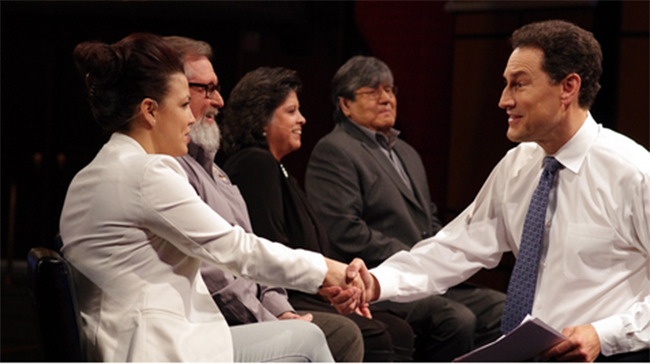TVO’s Agenda focuses on changing demographics in Thunder Bay

By Rick Garrick
THUNDER BAY — Red Rock First Nation’s Samantha Crowe called for a focus on the “amazing and wonderful things” First Nations youth are achieving during a recent The Agenda episode in Thunder Bay.
“Despite all the hardships and the struggles that young First Nations people face, there is a growing movement of empowerment, of wanting to have their voice heard, of creating awesome and powerful changes in their communities but also within the urban communities as well,” says the 21-year-old Lakehead University social work student and youth amplifier for the Provincial Advocate for Children and Youth. “We want to always make sure that we acknowledge all the positive stories and all the successful stories because that is what is going to bring people forward. To see other people are doing great things, you can realize that you don’t have to be stuck and that you are not powerless and that you can move forward and do greater things for your community.”
Crowe was one of six speakers, including four other First Nation speakers, during The Agenda On the Road: Building Thunder Bay broadcast, which was taped on March 8 and aired on March 9. The flagship current events TVO program focused on the changing demographics in Thunder Bay, where the Aboriginal population has almost doubled to varied estimates of 10-20 per cent over the last generation, and what they mean for First Nation and Metis communities in Thunder Bay and other mid-size Ontario cities.
“Having the initial discussions regarding race relations (and) growing up Aboriginal in the urban setting is fantastic,” Crowe says about the TVO broadcast. “They are much needed to have and to understand the realities that young people have to face. It’s a great first step in moving towards a better future for a healthier, safer community for everyone.”
Although Fort William Chief Georjann Morriseau noted her community has witnessed many successes over the years, including the recent graduation of a medical doctor, she says there are still misconceptions and stigmas attached to First Nation people about being “the burden to society.”
“We contribute a great deal to society and the economy,” Morriseau says, “so people have to stop looking at us as a burden walking into Walmart and flashing our status cards as though we have these superior rights.”
Morriseau called for partnerships to create better race relations in the area.
“How do we work together — is the goal to achieve a greater economy, a greater success, greater relationships, greater partnerships,” Morriseau says. “With partnerships comes opportunity, and we know that. So we’re not going to have those successful partnerships if we continue to look at the facile surface, if we continue to racially profile one another, if we continue to hang on to these stereotypes that we know, for a large part, are not accurate.”
Georgina Island’s Cynthia Wesley-Esquimaux says First Nations people are moving to Thunder Bay and other urban centres to pursue education and employment goals.
“It’s not necessarily a preference, I think in many instances it’s a necessity because there are not the jobs available in the communities and the education levels are going up,” says the vice-provost of Aboriginal Initiatives at Lakehead University, noting the Aboriginal community includes about 1,100 PhD graduates, 6,000 Masters graduates and 30,000 undergraduates across Canada according to 2006 statistics. “They need to work and they need to be engaged in the community building at home and externally in the urban centres. That is why they are coming, because they need to find the work to support their family.”


